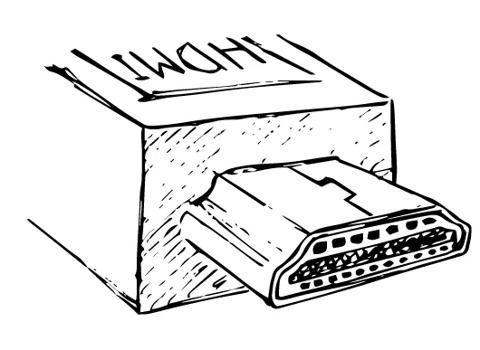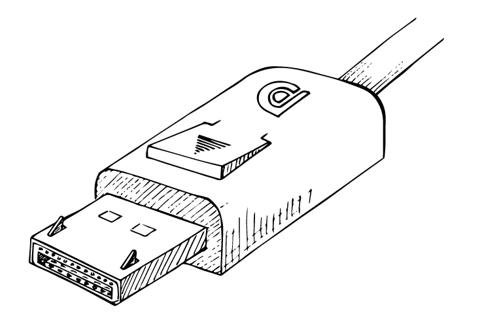Rückseite
22.01.2019
DisplayPort to HDMI conversion: should I use an active or a passive adapter?
BILDVERARBEITUNG - KÜNFTIGE ÜBERARBEITUNG Lesezeit 4 Min.
DisplayPort to HDMI adapters generally cost about 7 dollars. But if you want to go the other way round, you will need to dive a whole lot deeper into your pockets. The reason? An HDMI to DisplayPort conversion always requires an active instead of a passive adapter. But what exactly is going on inside these adapters, and is converting DP to HDMI always that easy? And is there a difference between consumer and professional use? In this article, we explore the complete reasoning.
As already explained in a previous article, DisplayPort and HDMI were created by different consortiums, with different applications in mind. HDMI was conceived by manufacturers of displays, whereas DisplayPort comes from the IT-world. In other words, we could say that DisplayPort comes from the video source side (AV receivers, computers, etc.), and HDMI more from the visualization side (HDTV, projectors, etc.). Oddly enough, this means that the display ports are usually HDMI ports. Although certainly not a general truth, it is more likely you want to connect a DisplayPort output to an HDMI input than the other way round.
DVI, HDMI and DisplayPort
First, let’s talk about the similarities between DVI and HDMI. Because HDMI was created as a follow-up to DVI, the two standards were very similar at the beginning. They both use TMDS (Transition-Minimized Differential Signaling), a technology to transmit data. Using a simple connector-to-connector type adapter cable, you could switch from DVI to HDMI and vice versa. This applies to single link DVI, supporting resolutions up to 2048 x 1200. For resolutions above HD, however, there is High Speed HDMI, which diverts from the dual link DVI you would use. So you do need an active adapter to make the conversion.
Note however that HDMI does support digital audio, whereas DVI is purely a video standard. So if you want to use both audio and video, you either need to use a (quite expensive) converter, or connect the audio to the display in a different way - for example via the headphone jack.

DisplayPort (and mini DisplayPort) on the other hand, is something completely different. It uses another signal type technology and even a lower cable voltage (3.3 V instead of the 5 V of HDMI/DVI). This makes the passive DP-to-HDMI adapter even more mysterious…
Making the translation
The tippy technology that allows the use of a simple passive adapter, is called HD DisplayPort Dual-Mode (or DP++). Although this is an optional feature and not part of the actual standard, it is available on most consumer devices’ video cards. You might find the DP++ logo on the device, but because it is so widespread most modern consumer products don’t mention the logo anymore.

The theory of DP++ is actually quite simple: when the device detects an MI adapter attached to it, the graphics card or GPU (Graphical Processing Unit) will automatically make a translation and send HDMI TMDS signals via the video output. The pins of the DisplayPort connector are then mapped onto the HDMI pins, making the transition very simple. The system is completely plug and play, handles both video and audio, and does not need any driver to work. You even don't really need a special adapter anymore, because there are DisplayPort to HDMI cables available on the market. There is normally no loss in quality when using such a dp to hdmi cable. Note however that this simple transition only applies to single-link DVI signals, so up to HD resolution. Furthermore, when you want to connect multiple DVI or HDMI monitors to a DisplayPort output, you will need an active adapter or splitter as well. Many graphics cards can’t support DP++ output to multiple monitors. Check with the customer service of the graphics card manufacturer for the type of adapter that suits your requirements the best.
And what about HDMI to DisplayPort conversions?
When going the other way round, things are less straightforward. HDMI does not support a way to force a signal translation onto the GPU. So an adapter with some computing power is always needed that does the computing at the connection. This explains the need for an active, more sophisticated adapter.
So why do screens with a DisplayPort interface even exist?
Does this easy conversion with DP++ mean that every screen or projector should just have an HDMI interface? No, it does not, because it’s always better to connect devices which use the same protocol. First of all, the voltage level-shifter circuit poses a restriction on the speed of the adapter. Although new adapters become available whenever an increase in bandwidth is introduced, you always need to buy the appropriate model. Furthermore, this only applies to Single-link DVI connections. Because a Dual-link DVI signal needs 25 pins, it cannot be transmitted from a DisplayPort connector using a passive adapter. You always need an active adapter converter to make this translation.

Note also that DP++ is not available on DisplayPort Alternate Mode over USB-C (as is used on many current compact devices like smartphones and notebooks). So if you use USB-C you will always need an active adapter to connect to an HDMI display.
What is Barco’s position in this?
The above text mostly applies to the consumer market. The professional market is quite different. Professional video equipment generally doesn’t have a GPU inside with DP++ capabilities. Our (and most other high-end devices) use different circuitry such as FPGA (Field Programmable Gate Array) and port processors to create the interfacing. As a result, they only accept the native signal of the interface.
For our displays and projectors, Barco makes sure we offer the optimal interface to our customers. This is why on most of our visualization devices you will find both DisplayPort and HDMI connections. The customer then has the freedom to always connect a source device with the same native interface to our products. Only in markets where only one standard is used by default (such as digital cinema that only uses HDMI), we restrict ourselves to a single connector – which is more straightforward and more cost-effective.

